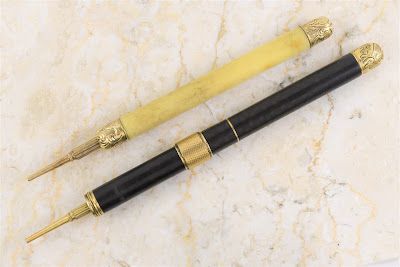This article has been edited and included in The Leadhead's Pencil Blog Volume 6, now on sale at The Legendary Lead Company. I have just a few hard copies left of the first printing, available here, and an ebook version in pdf format is available for download here.
If you don't want the book but you enjoy this article, please consider supporting the Blog project here.
We’ll call the top one “bone,” because once this virus thing peters out you can bet pinheaded bureaucrats will be back out in force, looking to string up anyone who looks like they’ve been hunting elephants lately. First, it really is bone, not ivory, and whatever poor creature’s innards were used, it happened nearly two centuries ago . . .
“Mabie’s Patent / Oct. 3 1854.” I have a couple other bone Mabie Todds, all identical to this one and all in better shape than this one. I’ve carefully posed it for these pictures so that the cracks in the barrel are on the other side.
That part I knew, even as I sat crosseyed with a dram in one hand and my eBay app in the other. It was the other one that was my real target in this auction. It has a very clear and to me very interesting imprint:
“Newton Kurtz & Co.” mid-barrel, and “C.Pat 51" near the top. The “C. Pat” imprint is a reference to Nelson Goodyear’s patent for hard rubber – called “Caoutchouc or India-Rubber” in his 1851 patent for the composition and method of manufacturing the stuff (that story is at https://leadheadpencils.blogspot.com/2018/03/c-pat.html).
However, it was Newton Kurtz & Co. that captured my attention. The firm fits into the century-long story of the evolution of one New York manufacturing house, which began with Albert Bagley in the 1840s and culminated with the establishment of Edward Todd & Co. in 1871 (that story began at https://leadheadpencils.blogspot.com/2018/03/from-bagley-through-todd-part-one.html and was later reworked for The Pennant). C.F. Newton & Co. was dissolved at the end of 1864, and Newton Kurtz & Co., a partnership consisting of Charles F. Newton, the colorful Keller Kurtz, and Joseph Moneghan, was formed effective January 1, 1865.
However, Newton had been in the business many years, having been associated with Albert Bagley and carrying on Bagley’s business after he left the firm in 1856. Newton retired from the firm effective May 1, 1867; the remaining partners stayed in business as Kurtz & Moneghan, which was succeeded by Edward Todd & Co. in 1870.
That means pencils marked Newton Kurtz & Co. were made during a very narrow period, between January 1, 1865 and May 1, 1867, which explains why I’ve only found one other so marked:
If my Newton Kurtz pencil looks like that bone Mabie Todd pencil, you’re right. The New York houses had a backroom deal to share technology with each other, reducing the sorts of competition they found counterproductive. Similarly, the combo is also Mabie Todd design, based on that same October 3, 1854 patent.
Sadly, I didn’t see in the auction listing that the pins are broken on the nib slider, and the nib has long since gone missing – that’s why this pair came to me so cheap. Ah well, I won’t complain about finding a second example of a Newton Kurtz, and one of these days I’ll learn how to repair these sliders.
Maybe even I’ll find a nib for it!





No comments:
Post a Comment